Forward (association football) facts for kids

In football, a forward (also called an attacker) is a player who mainly plays closer to the opponent's goal. Their most important job is to score goals for their team. Forwards are usually positioned further up the field than midfielders and defenders.
A forward needs to be good at finding open spaces to attack. They also need to be unpredictable to surprise the other team's defense. Because they focus on attacking, forwards typically score more goals than other players. Most modern teams use one to three forwards in their playing formations. For example, a common 4–2–3–1 formation usually has one main forward.
Forwards in Football: Your Guide to Attackers!
What Does a Forward Do?
Forwards are the main goal-scorers in football. They are always looking for chances to shoot the ball into the net. Besides scoring, they also help create opportunities for their teammates. This means they might pass the ball to another player in a good position. Their advanced position means they have fewer defensive duties than other players.
Different Kinds of Forwards
There are several types of forwards, each with special skills and roles. Understanding these roles helps you see how different players contribute to a team's attack.
The Goal Scorer: Centre-Forward and Striker
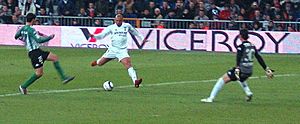
The centre-forward or striker is the main goal-scorer. They often wear the number 9 jersey. Their primary role is to put the ball in the back of the net.
Some centre-forwards are tall and strong. They are good at heading the ball and holding it up for teammates. This allows other players to run forward and join the attack. They can also pass the ball into the box for a teammate to score.
Other strikers are fast and have excellent ball control. Players like Ronaldo and Thierry Henry were known for their speed and dribbling. They could quickly get past defenders and shoot. Shorter, agile strikers like Sergio Agüero use their quick bursts of speed to get an advantage.
Good strikers can shoot well with both feet. They need power and accuracy in their shots. They also link up with teammates, passing the ball under pressure. While many wear number 9, creative forwards like Pelé sometimes wear number 10.
The Support Player: Second Striker

A second striker plays just behind the main forward. They are also called deep-lying forwards or support strikers. Their job is to create chances and score goals. They link the midfield with the attack.
Players like Dennis Bergkamp and Alessandro Del Piero were great second strikers. They would drop back to get the ball and then pass it to the main striker. They need good dribbling skills, vision, and passing ability. They can also score goals themselves.
This role is sometimes called a "nine-and-a-half." It combines the goal-scoring of a striker with the playmaking of an attacking midfielder. These players are often given freedom to move around the field. They can run forward or drop deeper to get the ball.
The Wide Attacker: Winger
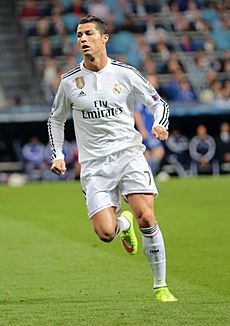
A winger plays on the sides of the field, near the touchlines. They are offensive players who attack from wide positions. In many parts of the world, they are still seen as forwards.
A winger's main duties include beating opposing full-backs. They then deliver crosses or cut-backs into the penalty box. These passes help central players score. Wingers are usually very fast and have excellent dribbling skills.
Some wingers are called inverted wingers. They play on the "wrong" side of the pitch. For example, a right-footed player might play on the left wing. This allows them to cut inside towards the goal and shoot with their stronger foot. Lionel Messi and Mohamed Salah are famous examples of inverted wingers.
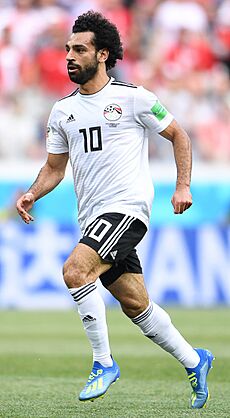
Sometimes, a winger might be called a "goalscoring winger." These players, like Cristiano Ronaldo, operate wide but often make runs into central areas. They aim to get into scoring positions inside the penalty box.
The Tricky Player: False 9
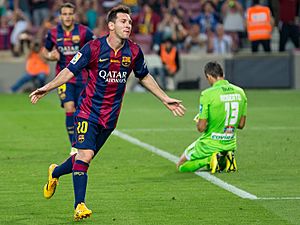
A false 9 is a special type of forward. Unlike a traditional striker who stays near the defenders, a false 9 drops deep into midfield. This creates a problem for the opponent's central defenders.
If the defenders follow the false 9, they leave a big space behind them. Other midfielders or wingers can then run into this space to attack. If the defenders don't follow, the false 9 has time and space to dribble or pass.
Key skills for a false 9 include great dribbling, good short passing, and excellent vision. They need to link up with midfielders and create chances for teammates. Lionel Messi has played this role very successfully for Barcelona. Nándor Hidegkuti for Hungary in the 1950s was an early example of this role.
The Strong Player: Target Forward
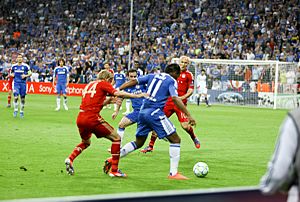
A target forward (or target man) is usually a tall and physically strong player. Their main job is to win high balls in the air. They also hold up the ball, meaning they keep possession while teammates move forward. This creates chances for others to score.
Players like Didier Drogba and Olivier Giroud are good examples. They are excellent at heading and playing with their back to the goal. They can receive a long pass, control it, and then pass to a teammate or turn and shoot. Target forwards are often marked closely by strong defenders.
Working Together: Striker Teams
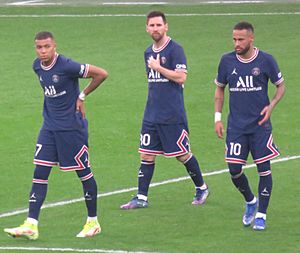
Teams often use two or more forwards who work together. These are called "strike teams." They combine their different skills to create more attacking options.
For example, a team might pair a tall, strong target forward with a smaller, faster, and more technical second striker. This combination can be very effective. The tall player wins the ball, and the fast player runs onto it to score. The duo of Edin Džeko and Sergio Agüero for Manchester City was a good example of this.
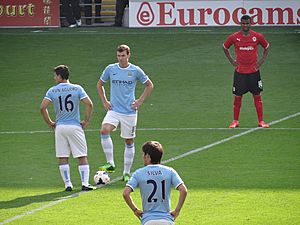
In women's football, Alex Morgan and Abby Wambach formed a powerful partnership for the U.S. national team. They scored many goals together in 2012, showing how effective two different types of forwards can be.
Forwards Play Defense Too!
Even though forwards are mainly attackers, they also play important defensive roles. They are often the first line of defense.
One key defensive tactic is high-pressing. This is when forwards push up the field to pressure the opponent's defenders. They try to win the ball back high up the pitch. By doing this, they can force the other team to make mistakes.
Forwards also cut out passing lanes. This means they position themselves to block passes between opposing players. This makes it harder for the other team to build their attack. By closing down opponents quickly, forwards help their team regain possession of the ball. So, even attackers contribute to the team's defense!
Images for kids
-
Vittorio Pozzo's Metodo system from the 1930s used attacking wingers or outside forwards.
See also
- Association football positions
- Association football tactics
- Defender
- Goalkeeper
- Midfielder




